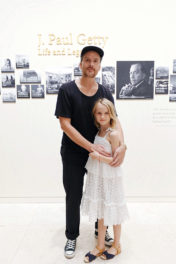This Saturday, October 22, the Getty Museum is teaming up with the Archaeological Institute of America to celebrate National Archaeology Day.
The Villa, with its Roman-inspired architecture and gardens and collection of Greek, Roman, and Etruscan antiquities, is a great place to explore the meaning and importance of archaeology—the study of past cultures through the material remains people have left behind. Tours this Saturday will explore archaeological themes, and a special Focus Tour at 3:00 p.m. will examine works of art with compelling histories.

As a college professor, a mother of elementary school-aged children, and now a visiting scholar, I’ve brought many groups of students and colleagues, ages 6 to 60, there over the years. What’s most striking to all who visit the Villa is the rich context its setting provides for appreciating the wonderful artworks in the galleries.
The Villa’s architecture and gardens are based on an extravagant ancient Roman country house in Herculaneum called the Villa dei Papiri, which was destroyed when Mt. Vesuvius erupted in the Bay of Naples in A.D. 79. In this context, the statues, paintings, jewelry, and pottery take on a new aura—or rather, they seem to repossess their ancient aura thanks to the Villa’s architectural and archaeological frame.
You begin to experience this frame before you even enter the building. As you stand outside the front doors and look in, you can see all the way to the very back of the Villa and through two of its many gardens. This first, impressive glimpse highlights the fact that the Roman house was an expression of wealth and status.

You then walk inside the grand doors, through the fauces or narrow “throat” of the house into the atrium, a large, somewhat open area with a skylight and fountain that catches rainwater. Beyond the atrium is the first of two spectacular peristyles, colonnaded garden spaces borrowed from the Greeks and decorated with fountains and sculpture as they would have been in antiquity.
Before you even reach the galleries you’re already beginning to experience the ancient world in context. You’re beginning to discover it like an archaeologist.
There are more frames and interesting juxtapositions inside the galleries, too. My favorite space is a very small room that holds many of the silver objects currently on display in the Villa. The walls of this room are covered with sumptuous marbles and other stones from all parts of what was the ancient Roman Empire. This “Hall of Colored Marbles” would have reminded visitors to the original Villa dei Papiri of the power and wealth of the home’s owner, and of Rome itself.

Carefully placed among the silver artifacts is a single grave relief of a silversmith practicing his craft. The inscription on the stone tells us that this individual was a freed slave, but we can see that he achieved a level of wealth that enabled him to commission a marble portrait of himself to be remembered in death.
For me, moments like these—seeing silver treasures alongside the faces of those who made objects like them, in the context of a room that speaks of ancient aspirations and empire—are what make visiting the Getty Villa so exciting. These ancient “material remains” create a dialogue with one another, with their setting, and with us, millennia after their creation.
I hope you’ll conduct your own explorations and find your own favorite spaces and moments at the Getty Villa next Saturday. See all events coming up this Saturday at the Villa and book your free tickets here.
Text of this post © Cynthia Colburn. All rights reserved.




Comments on this post are now closed.